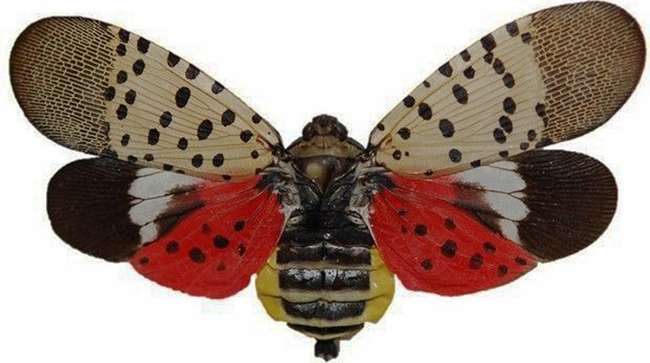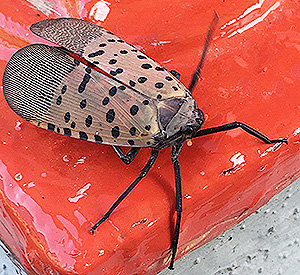Senior Reporter
Truckers Advised to Watch for Invasive Spotted Lanternfly

[Stay on top of transportation news: Get TTNews in your inbox.]
State and federal agriculture officials in several Northeastern states are having limited success in containing the spread of the spotted lanternfly, an invasive insect from China threatening billions of dollars in crop losses.
The tiny insect, first spotted by an off-duty game officer in southeastern Pennsylvania’s Berks County in September 2014, so far has infested counties in Virginia, Delaware, Maryland and, most recently, New Jersey.
“I don’t think that eradication of the insect is likely,” said Heather Leach, a spotted lanternfly expert with the Penn State Extension of the College of Agricultural Sciences. “But I think what’s happening on the ground with U.S. Department of Agriculture and Pennsylvania Department of Agriculture are hopefully helping us to slow down the spread and contain it as much as possible.”

(Melissa Chippie)
Lanternflies Spotted
In an August update letter, Osama El-Lissy, deputy administrator of USDA’s Plant Protection and Quarantine, said officials have documented infestations of the pest. The affected areas:
Virginia
- Winchester City, Frederick County
New Jersey
- Burlington, Camden, Gloucester, Salem, Somerset, Warren, Mercer and Hunterdon counties
Pennsylvania
- Berks, Bucks, Carbon, Chester, Delaware, Lancaster, Lebanon, Lehigh, Monroe, Montgomery, Northampton, Philadelphia and Schuylkill counties
Delaware
- New Castle County
Maryland
- Cecil County
The lanternfly doesn’t bite and doesn’t sting: It just literally sucks the life out of 70 different species of trees and plants, feeding on such crops as grapes, apples, hops and walnuts, according to agricultural experts.
Truckers doing business in counties under quarantine are playing an unwitting role in the spread of the bug that “hitchhikes” rides on motor vehicles delivering and picking up loads. The problem has become so concerning in those areas that most truck drivers are required to display stickers indicating they have received training and have been issued permits. Trucks that are caught traveling with lanternflies onboard in quarantined areas during inspections can even be placed out of service.
The most recent invasion of the destructive lanternfly has been documented in New Jersey, where it has spread in recent months from three to nine quarantined counties, Leach said.
“We really have seen them hit areas that they haven’t in the past,” Leach told Transport Topics. “Philly is a good example of that — but also Allentown, which is a big trucking hub. High populations of people haven’t been used to dealing with them. So it’s kind of like the crazy started all over again.”
Along the way, truck and car drivers often have been unaware that the lanternfly can hide inside such places as vehicle wheel wells and underneath windshield wiper compartments. They even can jump into open windows, allowing them to “hitchhike” to their next hosts on which to feed.
“Drivers are told to look over their vehicles when they go into those areas to make sure there’s no bugs hitching a ride,” said Gail Toth, executive director of the New Jersey Motor Truck Association. “I’ve heard that now people are getting worried that they could be transported on Christmas trees. I don’t know how they’re going to stop something like that, honestly.”
Leach said the good news is that research into the insect is helping better understand its nature. Although it originally was believed the lanternfly could not actually fly, researchers are discovering that in the proper environment it can climb to heights that allow it to ride thermals — updrafts of warm air — permitting it to travel up to 60 meters in 24 hours.
Although New York officials have yet to document an infestation of the insects, they say it is possibly present in low numbers and not yet detected.
“Given the proximity of the Pennsylvania infestation, it is expected to be found in New York eventually,” state agricultural officials said in an information update.
Meanwhile, agriculture officials in California earlier this year awarded a $544,000 preventative project in anticipation that the lanternfly could jump a ship from China and land at one of the state’s ports.
The three-year project titled “Proactive Biological Control of Spotted Lantern Fly, Lycorma delicatula,” will proactively develop biological control agents for the spotted lanternfly, “an invasive pest that has not yet arrived in California but is spreading rapidly across the eastern U.S.”
“This pest has the potential to affect many high-value California crops including grapes, walnuts, avocados, and pistachios,” a statement from the California Department of Food and Agriculture said. “The project will piggyback on work that is already being conducted on the pest in the eastern U.S. and abroad. The biological control agent is a small stingless wasp, native to China, that parasitizes the eggs of the spotted lanternfly.”
Want more news? Listen to today's daily briefing:




